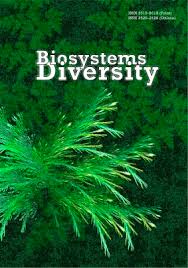Fruit and berry plants of forest belts as a factor of species diversity of ornithofauna during the breeding season and autumn migration period
Fruit and berry plants of forest belts as a factor of species diversity of ornithofauna during the breeding season and autumn migration period
Author(s): V. V. Pesotskaya, A. B. Chaplygina, T. V. Shupova, R. I. KratenkoSubject(s): Energy and Environmental Studies, Sociobiology
Published by: Дніпропетровський національний університет імені Олеся Гончара
Keywords: migrations of birds; feed; numerical composition; floristic composition;
Summary/Abstract: During migration, the availability of food that affects the success of bird movements, the nature and timing of their movements, is critical for many bird species. The relationship between migration routes and the ripening of fruit and berry plants along the route is important. Four types of forest belts were studied: wind-blown maple-ash, latticed maple-linden, dense oak-maple-linden, wind-blown oak-maple-poplar. During the study 43 bird species were identified consuming 9 major fruit and berry plant species: Sambucus nigra, Prunus spinosa, Crataegus laevigata, Rosa canina, Prunus padus, Sorbus aucuparia, Rhamnus cathartica, Morus nigra, Prunus cerasus. The highest average number of birds feeding in forest belts (4.14 ind./km) was registered in oak-maple-linden dense forest belts, while the lowest number (1.48 ind./km) was recorded in wind-blown maple-ash ones. Maple-linden latticed forest belts characterize the best index data of α-diversity of birds. In the summer-autumn diet, succulent fruit are the most important: Starling (Sturnus vulgaris) - 11.8% of the total number of birds observed to feed on this food resource, Greenfinch (Chloris chloris) - 11.3%, Chaffinch (Fringilla coelebs) - 9.3%, Song thrush (Turdus philomelos) - 7.3%, Hawfinch (Coccothraustes coccothraustes) - 7.1%, Blackbird (Turdus merula) - 5.4%. 42 species of birds were observed to feed on black elderberry. More than half (51.2%) of the species composition of birds feeding on fruit and berry plants were migratory birds. Consequently, juicy berries are an important food during bird migrations.
Journal: Biosystems Diversity
- Issue Year: 28/2020
- Issue No: 3
- Page Range: 290-297
- Page Count: 8
- Language: English

